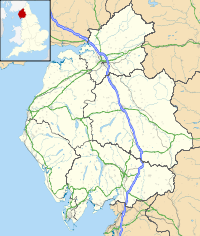- St Bridget's Church, Brigham
-
St Bridget's Church, Brigham 
St Bridget's Church, Brigham, from the southwestLocation in Cumbria Coordinates: 54°39′54″N 3°25′08″W / 54.6651°N 3.419°W OS grid reference NY 085 309 Location Brigham, Cumbria Country England Denomination Anglican History Dedication St Bridget Significant associated people Fletcher Christian Architecture Status Parish church Functional status Active Heritage designation Grade I Designated 3 March 1967 Architect(s) William Butterfield (restoration) Architectural type Church Style Norman, Gothic and
Gothic RevivalSpecifications Materials Calciferous sandstone with green slate roofs Administration Parish Brigham Deanery Solway Archdeaconry West Cumberland Diocese Carlisle Province York St Bridget's Church, Brigham, is in the village of Brigham, Cumbria, England. It is an active Anglican parish church in the deanery of Solway, the archdeaconry of West Cumberland, and the diocese of Carlisle.[1] The church has been designated by English Heritage as a Grade I listed building.[2]
Contents
History
The church dates from the later part of the 11th century, with additions and alterations in the 12th and 13th centuries.[2] The south aisle was re-built in the 14th century. The architectural historian Nikolaus Pevsner was of the opinion that this was founded in 1323 as a chantry for the rector, Thomas de Burgh.[3] Restoration of the church was carried out between 1864 and 1876 by William Butterfield; this included adding the east window and the south windows of the chancel, and the saddleback roof on the tower.[3] The timber roofs of the nave and chancel also date from this restoration.[2] Fletcher Christian, leader of the Mutiny on the Bounty, was baptised in the church on the day of his birth in 1764.[1][4]
Architecture
Exterior
St Bridget's is constructed in calciferous sandstone ashlar, and has a green slate roof. Its plan consists of a three-bay nave with a south aisle and south porch, and a two-bay chancel with a north vestry. At the west end is a three-storey tower with a saddleback roof, and at the ends of the gables are cross finials.[2] The church contains elements of Norman, Gothic and Gothic Revival architecture. The Norman features include a blocked doorway in the north wall, and the arcade between the nave and the south aisle. The ground floor of the tower is tunnel-vaulted.[3] Medieval cross slabs have been incorporated in the north wall and in the blocked west door.[2]
Interior
Both the nave and the chancel have painted timber roofs. The south aisle contains a piscina, a sedilia, and a recess for the tomb of Thomas de Burgh, who died in 1348.[2] In the church are pieces of carved stone; these include an Anglo-Danish cross-socket, and fragments dating from the pre-Norman period.[3] The east window contains stained glass depicting the Ascension, designed by Alexander Gibbs, and is a memorial to Rev John Wordsworth, son of William Wordsworth, who was vicar of the church for 40 years.[4] On each side of the east window are niches for statues.[3] There is more glass by Gibbs in other windows, dating from 1865, and glass elsewhere by Cox & Buckley and Sons, from 1870.[2][4] The font dates either from the 13th century[2] or possibly from the 17th century.[3] The two-manual organ was built in 1895 by W. Hill and Son of London.[5]
External features
In the churchyard is a red sandstone sundial dated 1684. It has a square shaft, the head is weathered and the gnomon is missing. The sundial is a Grade II listed structure.[6] The churchyard also contains many carved gravestones from the 17th to the 19th centuries, and the table tomb of Fletcher Christian's father.[7]
See also
- Grade I listed buildings in Cumbria
References
- ^ a b Brigham, St Bridget, Church of England, http://www.achurchnearyou.com/brigham-st-bridget/, retrieved 21 March 2010
- ^ a b c d e f g h "Church of St Bridget, Brigham", The National Heritage List for England (English Heritage), 2011, http://list.english-heritage.org.uk/resultsingle.aspx?uid=1145196, retrieved 12 May 2011
- ^ a b c d e f Pevsner, Nikolaus (2002) [1967], Cumberland and Westmorland, The Buildings of England, New Haven and London: Yale University Press, pp. 78–79, ISBN 0-300-09590-2
- ^ a b c Brigham - St Bridget's Church, Visit Cumbria, http://www.visitcumbria.com/cm/chc13.htm, retrieved 22 March 2010
- ^ Cumberland, Brigham, St Bridget, British Institute of Organ Studies, http://www.npor.org.uk/cgi-bin/Rsearch.cgi?Fn=Rsearch&rec_index=N03575, retrieved 24 March 2010
- ^ "Sundial south of Church of St Bridget, Brigham", The National Heritage List for England (English Heritage), 2011, http://list.english-heritage.org.uk/resultsingle.aspx?uid=1311963, retrieved 12 May 2011
- ^ Alexander, Caroline (2003). The Bounty: The True Story of the Mutiny on the Bounty. New York: Viking. ISBN 067003133X. pp. 359-60.
Categories:- Church of England churches in Cumbria
- Grade I listed buildings in Cumbria
- Norman architecture
- English Gothic architecture
- Gothic Revival architecture in England
- Diocese of Carlisle
Wikimedia Foundation. 2010.

